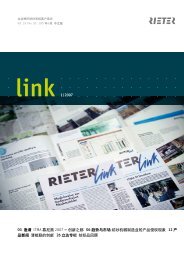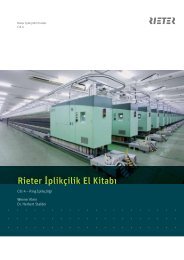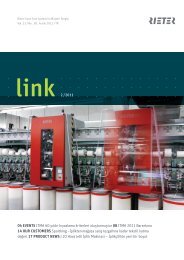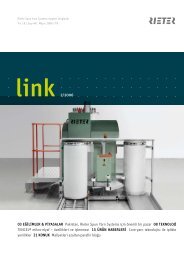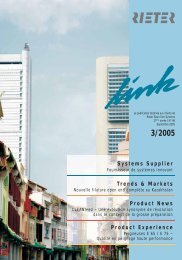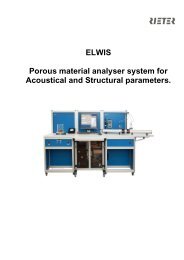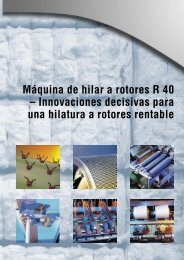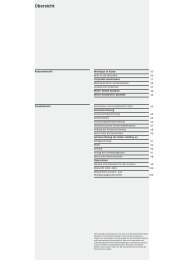Create successful ePaper yourself
Turn your PDF publications into a flip-book with our unique Google optimized e-Paper software.
Optimal use of resources with<br />
compact ringspinning<br />
The compact spinning process has become firmly established in the marketplace<br />
in recent years. The quality improvements achieved through<br />
using the compacting process open up many opportunities for utilization<br />
by spinning mills and downstream processors. This article reports<br />
on experience gained in an Indian spinning mill.<br />
Raw material<br />
utilization can be<br />
improved with the<br />
Com4® compacting<br />
unit.<br />
The compacting process has resulted in a surge in<br />
quality in conventional ring-spun yarn. Compact<br />
yarn displays considerably improved yarn parameters,<br />
especially in terms of hairiness and dynamometric<br />
stretch recovery. Its technological superiority<br />
is undisputed, as are the potential cost savings in<br />
downstream processes and in the fabric itself.<br />
The potential for optimization offered by the compact<br />
spinning process has been studied in cooperation<br />
with an Indian customer. Quality, output or raw material<br />
are the focus of the spinning objectives here,<br />
and serve to compare the two spinning systems.<br />
<strong>LINK</strong> 55 . 2 /2010<br />
TECHNOLOGY<br />
The development of compact spinning<br />
<strong>Rieter</strong> introduced the compact spinning process to<br />
the global ring spinning market 10 years ago. The<br />
primary goal of this development was lower hairiness<br />
and higher yarn tenacity and elongation. Two<br />
compacting systems dominate the world market –<br />
<strong>Rieter</strong>’s Com4® system and Suessen’s Elite® system.<br />
Compact spinning was originally used mainly for finer<br />
yarn counts and weaving yarns. In the meantime,<br />
its scope of application has also been extended to<br />
coarser yarn counts and knitting yarns.<br />
Spinning with different objectives<br />
Many modern ring spinning mills operate conventional<br />
ring spinning and compact spinning machines<br />
side by side, thus offering mill operators the greatest<br />
possible flexibility in meeting customers’ differing<br />
requirements. The Indian mill selected for this<br />
comparative study produces Ne 40 knitting yarns for<br />
hosiery – on both spinning systems.<br />
Quality and output as the spinning objective<br />
Although yarns from conventional ring spinning<br />
and compact spinning machines cannot be mixed in<br />
downstream processing, Indian spinning mills often<br />
make no distinction between the yarns, i.e. do not label<br />
compact yarns specifically as such. They sell both<br />
yarns on the market as “ring-spun yarn”, without any<br />
differentiation.<br />
In the first part of the study the two spinning processes<br />
were compared with the focus on an optimum<br />
yarn outcome (Table 1). Both types of machine operate<br />
at the same spindle speeds. On the compact<br />
spinning machine the twist factor was considerably<br />
reduced. This resulted in an increase in output<br />
of 7 422 kg per machine and year compared to the<br />
conventional ring spinning machine, equivalent to a<br />
20. % increase in production. The smaller spinning<br />
triangle in the compact spinning process results in<br />
improved running behavior and a reduction in ends<br />
down from 60 to 40 per 1 000 spindle hours.<br />
19




